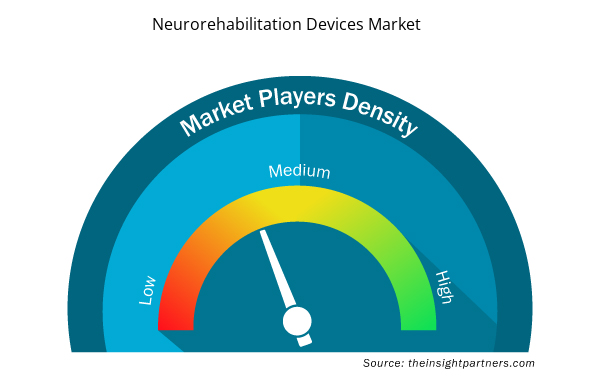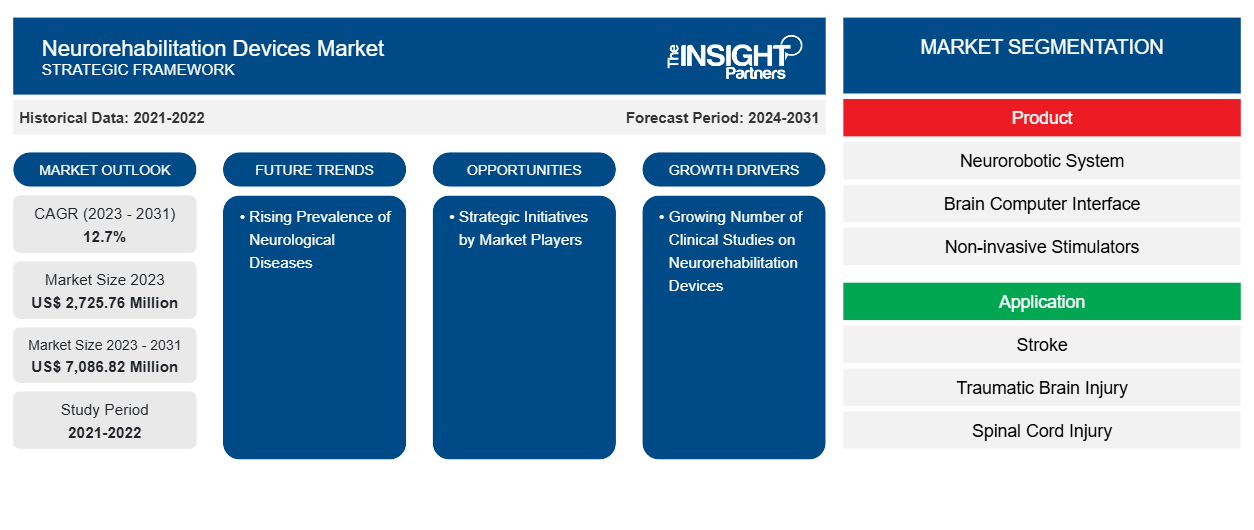神经康复设备市场规模预计将从 2023 年的 27.2576 亿美元增至 2031 年的 70.8682 亿美元。预计 2023-2031 年期间市场复合年增长率将达到12.7%。神经康复设备的技术进步可能会在未来几年为神经康复设备市场带来新趋势。
神经康复设备市场分析
越来越多的创伤性脑损伤 ( TBI ) 幸存者寻求有效的康复解决方案,这推动了对神经康复设备的需求,有利于市场增长。此外,机器人技术和脑机接口等神经康复技术进步提高了治疗效果和患者参与度,推动了神经康复设备市场的增长。神经系统疾病的发病率不断上升和老龄化人口进一步促进了市场扩张。此外,对早期和个性化康复疗法益处的更多了解鼓励医疗保健提供者采用创新的神经康复设备,最终改善患者的治疗效果和生活质量。
神经康复设备市场概况
神经康复设备市场正在迅速发展,这得益于技术进步和对有效康复解决方案不断增长的需求。全球人口中中风和其他神经退行性疾病的发病率不断上升,进一步推动了市场的增长。根据 2024 年 4 月发表的一篇题为“评估沙特阿拉伯Al-Ahsa公共活动参与者对帕金森病的看法:调查前后”的文章,沙特阿拉伯帕金森病 (PD) 的患病率估计为每 100,000 人口 27 人。随着年龄的增长,患神经退行性疾病的可能性会增加。这需要一个强大的康复框架来解决这些人面临的独特挑战,包括行动不便、平衡问题和认知能力下降。神经康复设备在改善 PD 患者的生活质量方面发挥着至关重要的作用。这些设备可以帮助进行物理治疗、提高运动技能并提供认知训练。
根据 2023 年 5 月发表的一篇题为“中东和北非地区的中风护理:挑战、进展和有希望的途径”的文章,在该国,每年有 8,000 至 10,000 人中风。神经康复设备对于中风康复、解决运动障碍、利用创新技术以及通过沉浸式疗法增强患者参与度至关重要。此外,随着医疗保健提供者越来越多地采用创新解决方案来改善患者治疗效果,神经康复设备市场未来有望实现显着增长。
定制此报告以满足您的需求
您可以免费定制任何报告,包括本报告的部分内容、国家级分析、Excel 数据包,以及为初创企业和大学提供优惠和折扣
- 获取此报告的关键市场趋势。这个免费样品将包括数据分析,从市场趋势到估计和预测。
神经康复设备市场驱动因素和机遇
神经康复设备临床研究数量不断增加
临床研究验证了新开发的神经康复设备的安全性和有效性。它们提供了神经康复设备有助于提高神经系统疾病患者的生活质量的证据。这些研究鼓励医疗中心将这些设备整合到他们的治疗计划中。例如,2023 年 2 月发表了《可穿戴远程康复训练系统对中风患者的临床研究:随机对照试点试验》。该临床研究旨在设计一种基于可穿戴设备和人机交互训练任务的远程智能康复训练系统,并评估其安全性和效率。
堪萨斯大学医学中心的研究人员正在研究可穿戴技术,这是一项全国性中风康复临床试验的一部分。专家们正在测试可穿戴设备的有效性,这些设备可以刺激大脑和脊髓中的电磁能,这可能有助于减少中风后的残疾。
2022 年 12 月,一项临床试验研究“使用Erigo设备进行机器人康复对神经损伤患者的影响:随机临床试验的系统评价和荟萃分析”发表。该试验根据安全性、肌肉强度、痉挛、功能性、步态/平衡和意识水平变化等参数研究了Erigo机器人康复设备对神经损伤患者的影响。研究得出结论, Erigo作为一种机器人康复设备,对后天性脑损伤患者是安全的,并且可以减少中风患者的痉挛。因此,神经康复设备临床研究数量的增加有利于全球市场的增长。
市场参与者的战略举措
市场参与者采取的合并、收购、伙伴关系和协作等战略举措可能会加速创新、发展专业知识并扩大市场范围。
2022 年 4 月,Blackrock Neurotech 与神经技术初创公司 Phantom Neuro 合作,对 Phantom Neuro 正在申请专利的 Phantom X 系统进行研发,该系统为患者提供对当前和下一代辅助设备(如假肢和外骨骼)的高精度、近乎实时的控制。此次研发合作使 Phantom 能够利用 Blackrock 在神经技术领域的数十年经验,开发生物相容性植入式传感器来增强 Phantom X 平台。
2022 年 12 月,医疗用外骨骼技术领导者 Ekso Bionics 宣布收购派克汉尼汾公司的人体运动与控制 (HMC) 业务部门。此次收购将增强 Ekso 的产品组合,并改善其与范德堡大学等商业和研究合作伙伴的战略关系。与范德堡大学的合作有望增强其研究能力和产品开发。
因此,市场参与者采取的战略举措很可能在不久的将来为神经康复市场创造丰厚的机会。
神经康复设备市场报告细分分析
有助于得出神经康复设备市场分析的关键部分是产品类型、应用和最终用户。
- 根据产品类型,神经康复设备市场分为神经机器人系统、脑机接口、非侵入式刺激器和可穿戴设备。脑机接口部分在 2023 年占据了最大的市场份额。
- 根据应用,市场分为中风、脊髓损伤、脑瘫、创伤性脑损伤、帕金森病等。中风领域在 2023 年占据了神经康复设备市场的最大份额。
- 从终端用户来看,神经康复设备市场分为医院和诊所、康复中心和家庭护理。2023 年,医院和诊所占据了市场主导地位。
神经康复设备市场份额按地区分析
神经康复设备市场报告的地理范围主要分为五个区域:北美、亚太、欧洲、中东和非洲、南美和中美。
2023 年,北美占据了相当大的市场份额。市场的增长是由脑瘫和脊髓损伤等神经系统疾病的日益流行以及神经康复设备领域的技术进步所推动的。此外,新产品的推出和先进神经康复设备的研发不断增加预计将加速该地区神经康复设备市场的增长。
根据加拿大脑损伤协会的报告,TBI 是导致残疾的主要原因,每年有 2% 的加拿大人需要住院 18,000 次。根据滑铁卢-惠灵顿脑损伤协会的数据,加拿大每年每 100,000 人中就有 500 人患有 TBI;每年有超过 6,000 名患者因 TBI 而永久残疾。神经康复设备的整合是 TBI 患者康复过程的关键部分。这些设备(包括机器人系统和认知辅助设备)通过提供个性化治疗来促进有针对性的康复,从而增强运动技能和认知功能。
神经康复设备市场区域洞察
Insight Partners 的分析师已详尽解释了预测期内影响神经康复设备市场的区域趋势和因素。本节还讨论了北美、欧洲、亚太地区、中东和非洲以及南美和中美洲的神经康复设备市场细分和地理位置。

- 获取神经康复设备市场的区域特定数据
神经康复设备市场报告范围
| 报告属性 | 细节 |
|---|---|
| 2023 年的市场规模 | 27.2576亿美元 |
| 2031 年市场规模 | 70.8682亿美元 |
| 全球复合年增长率(2023 - 2031) | 12.7% |
| 史料 | 2021-2022 |
| 预测期 | 2024-2031 |
| 涵盖的领域 | 按产品
|
| 覆盖地区和国家 | 北美
|
| 市场领导者和主要公司简介 |
|
市场参与者密度:了解其对商业动态的影响
神经康复设备市场正在快速增长,这得益于终端用户需求的不断增长,而这些需求又源于消费者偏好的不断变化、技术进步以及对产品优势的认识不断提高等因素。随着需求的增加,企业正在扩大其产品范围,进行创新以满足消费者的需求,并利用新兴趋势,从而进一步推动市场增长。
市场参与者密度是指在特定市场或行业内运营的企业或公司的分布情况。它表明在给定市场空间中,相对于其规模或总市场价值,有多少竞争对手(市场参与者)存在。
在神经康复设备市场运营的主要公司有:
- 贝莱德微系统公司
- 霍科马公司
- 美敦力公司
- Tyromotion 有限公司
- Ekso Bionics 控股公司
- 比奥尼克
免责声明:上面列出的公司没有按照任何特定顺序排列。

- 了解神经康复设备市场的主要参与者概况
神经康复设备市场新闻和最新发展
神经康复设备市场通过收集一级和二级研究后的定性和定量数据进行评估,其中包括重要的公司出版物、协会数据和数据库。神经康复设备市场的一些发展如下所列:
- Ekso Bionics Holdings, Inc. 获得美国食品药品监督管理局 (FDA) 的 510(k) 批准,可销售用于多发性硬化症患者的 EksoNR 机器人外骨骼。这是首个获得 FDA 批准用于多发性硬化症患者康复的外骨骼设备。这一适应症大大扩展了该设备对更广泛患者群体的使用。除了获得 FDA 批准外,EksoNR 还获得 CE 标志并可在欧洲购买。(来源:Ekso Bionics Holdings, Inc.,新闻稿,2022 年 6 月)
- DIH 是一家全球领先的机器人和虚拟现实 (VR) 技术公司,致力于提供先进的康复护理服务,该公司宣布将 2020 年与 Gorbel, Inc. 达成的战略商业协议转变为完全收购其康复部门。所有三款 SafeGait 设备将继续在美国生产,目前已在 FDA 上以 DIH Technology, Inc. 的名义上市。(来源:DIH,新闻稿,2022 年 10 月)
神经康复设备市场报告覆盖范围和交付成果
“神经康复设备市场规模和预测(2021-2031)”报告对以下领域进行了详细的市场分析:
- 神经康复设备市场规模及预测,涵盖全球、区域和国家层面的所有主要细分市场
- 神经康复设备的市场趋势,以及驱动因素、限制因素和关键机遇等市场动态
- 详细的 PEST 和 SWOT 分析
- 神经康复设备市场分析涵盖主要市场趋势、全球和区域框架、主要参与者、法规和最新市场发展
- 行业格局和竞争分析,涵盖市场集中度、热图分析、知名参与者以及神经康复设备市场的最新发展
- 详细的公司简介
- 历史分析(2 年)、基准年、预测(7 年)及复合年增长率
- PEST 和 SWOT 分析
- 市场规模价值/数量 - 全球、区域、国家
- 行业和竞争格局
- Excel 数据集


- Airport Runway FOD Detection Systems Market
- Influenza Vaccines Market
- Compounding Pharmacies Market
- Hair Extensions Market
- Dealer Management System Market
- Medical Second Opinion Market
- Artwork Management Software Market
- Airline Ancillary Services Market
- Blood Collection Devices Market
- Clinical Trial Supplies Market

Report Coverage
Revenue forecast, Company Analysis, Industry landscape, Growth factors, and Trends

Segment Covered
This text is related
to segments covered.

Regional Scope
North America, Europe, Asia Pacific, Middle East & Africa, South & Central America

Country Scope
This text is related
to country scope.
常见问题
North America dominated the neurorehabilitation devices market in 2023.
Blackrock Microsystems Inc, Hocoma AG, Medtronic Plc, Tyromotion GmbH, Ekso Bionics Holdings Inc, BIONIK, Abbott Laboratories, Renishaw Plc, EMOTIV, and BioXtreme Ltd are among the key players operating in the neurorehabilitation devices market.
The increasing prevalence of neurological diseases worldwide and the growing number of clinical studies on neurorehabilitation devices are the most influential factors responsible for the market growth.
The global neurorehabilitation devices market is estimated to register a CAGR of 12.7% during the forecast period.
The estimated value of the neurorehabilitation devices market can reach US$ 7,086.82 million by 2031.
Trends and growth analysis reports related to Life Sciences : READ MORE..
The List of Companies - Neurorehabilitation Devices Market
- Blackrock Microsystems Inc
- Hocoma AG
- Medtronic Plc
- Tyromotion GmbH
- Ekso Bionics Holdings Inc
- BIONIK
- Abbott Laboratories
- Renishaw Plc
- EMOTIV
- BioXtreme Ltd.
The Insight Partners performs research in 4 major stages: Data Collection & Secondary Research, Primary Research, Data Analysis and Data Triangulation & Final Review.
- Data Collection and Secondary Research:
As a market research and consulting firm operating from a decade, we have published and advised several client across the globe. First step for any study will start with an assessment of currently available data and insights from existing reports. Further, historical and current market information is collected from Investor Presentations, Annual Reports, SEC Filings, etc., and other information related to company’s performance and market positioning are gathered from Paid Databases (Factiva, Hoovers, and Reuters) and various other publications available in public domain.
Several associations trade associates, technical forums, institutes, societies and organization are accessed to gain technical as well as market related insights through their publications such as research papers, blogs and press releases related to the studies are referred to get cues about the market. Further, white papers, journals, magazines, and other news articles published in last 3 years are scrutinized and analyzed to understand the current market trends.
- Primary Research:
The primarily interview analysis comprise of data obtained from industry participants interview and answers to survey questions gathered by in-house primary team.
For primary research, interviews are conducted with industry experts/CEOs/Marketing Managers/VPs/Subject Matter Experts from both demand and supply side to get a 360-degree view of the market. The primary team conducts several interviews based on the complexity of the markets to understand the various market trends and dynamics which makes research more credible and precise.
A typical research interview fulfils the following functions:
- Provides first-hand information on the market size, market trends, growth trends, competitive landscape, and outlook
- Validates and strengthens in-house secondary research findings
- Develops the analysis team’s expertise and market understanding
Primary research involves email interactions and telephone interviews for each market, category, segment, and sub-segment across geographies. The participants who typically take part in such a process include, but are not limited to:
- Industry participants: VPs, business development managers, market intelligence managers and national sales managers
- Outside experts: Valuation experts, research analysts and key opinion leaders specializing in the electronics and semiconductor industry.
Below is the breakup of our primary respondents by company, designation, and region:

Once we receive the confirmation from primary research sources or primary respondents, we finalize the base year market estimation and forecast the data as per the macroeconomic and microeconomic factors assessed during data collection.
- Data Analysis:
Once data is validated through both secondary as well as primary respondents, we finalize the market estimations by hypothesis formulation and factor analysis at regional and country level.
- Macro-Economic Factor Analysis:
We analyse macroeconomic indicators such the gross domestic product (GDP), increase in the demand for goods and services across industries, technological advancement, regional economic growth, governmental policies, the influence of COVID-19, PEST analysis, and other aspects. This analysis aids in setting benchmarks for various nations/regions and approximating market splits. Additionally, the general trend of the aforementioned components aid in determining the market's development possibilities.
- Country Level Data:
Various factors that are especially aligned to the country are taken into account to determine the market size for a certain area and country, including the presence of vendors, such as headquarters and offices, the country's GDP, demand patterns, and industry growth. To comprehend the market dynamics for the nation, a number of growth variables, inhibitors, application areas, and current market trends are researched. The aforementioned elements aid in determining the country's overall market's growth potential.
- Company Profile:
The “Table of Contents” is formulated by listing and analyzing more than 25 - 30 companies operating in the market ecosystem across geographies. However, we profile only 10 companies as a standard practice in our syndicate reports. These 10 companies comprise leading, emerging, and regional players. Nonetheless, our analysis is not restricted to the 10 listed companies, we also analyze other companies present in the market to develop a holistic view and understand the prevailing trends. The “Company Profiles” section in the report covers key facts, business description, products & services, financial information, SWOT analysis, and key developments. The financial information presented is extracted from the annual reports and official documents of the publicly listed companies. Upon collecting the information for the sections of respective companies, we verify them via various primary sources and then compile the data in respective company profiles. The company level information helps us in deriving the base number as well as in forecasting the market size.
- Developing Base Number:
Aggregation of sales statistics (2020-2022) and macro-economic factor, and other secondary and primary research insights are utilized to arrive at base number and related market shares for 2022. The data gaps are identified in this step and relevant market data is analyzed, collected from paid primary interviews or databases. On finalizing the base year market size, forecasts are developed on the basis of macro-economic, industry and market growth factors and company level analysis.
- Data Triangulation and Final Review:
The market findings and base year market size calculations are validated from supply as well as demand side. Demand side validations are based on macro-economic factor analysis and benchmarks for respective regions and countries. In case of supply side validations, revenues of major companies are estimated (in case not available) based on industry benchmark, approximate number of employees, product portfolio, and primary interviews revenues are gathered. Further revenue from target product/service segment is assessed to avoid overshooting of market statistics. In case of heavy deviations between supply and demand side values, all thes steps are repeated to achieve synchronization.
We follow an iterative model, wherein we share our research findings with Subject Matter Experts (SME’s) and Key Opinion Leaders (KOLs) until consensus view of the market is not formulated – this model negates any drastic deviation in the opinions of experts. Only validated and universally acceptable research findings are quoted in our reports.
We have important check points that we use to validate our research findings – which we call – data triangulation, where we validate the information, we generate from secondary sources with primary interviews and then we re-validate with our internal data bases and Subject matter experts. This comprehensive model enables us to deliver high quality, reliable data in shortest possible time.


 获取此报告的免费样本
获取此报告的免费样本